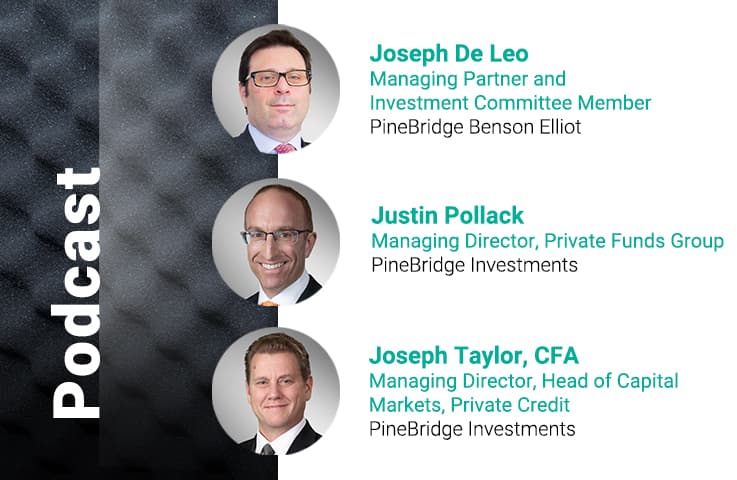2024 Private Funds Outlook: Bright Spots Amid the Headwinds

Justin Pollack
Managing Director, Private Funds Group

Steven Costabile, CFA
Global Head of Private Funds Group
Initiating a new buyout is more challenging and expensive today than it was 18 months ago, as the higher cost of debt is not offset with lower purchase prices. This reality has required many private equity investors to adapt their approach to add value in portfolios.
Anticipated challenges in exiting buyout investments mean selectivity is especially critical when considering new strategies.
To maintain returns consistent with those in the recent past, investors must identify opportunities with the potential to create value in portfolio companies without relying solely on precarious financial engineering.
The middle-market segment may be attractive in this environment, yielding potential for operational improvements that are expected to help offset deterioration in financing economics. Further, investors appear focused on opportunities that may accelerate liquidity during this difficult period.

For the past decade, leveraged buyouts have repeatedly demonstrated better returns than comparable public market indices.1 Yet with the rise in interest rates over the past year and a half, an obvious question is whether cheap debt fueled this outperformance – and how a new environment might affect private equity in 2024 and beyond.We believe identifying opportunities in private equity will require a narrower focus on strategies that can mitigate emerging financing challenges and present novel ways of generating alpha in portfolios. Many investors have found the middle-market segment to be attractive in this environment, yielding potential for operational improvements that are expected to help offset deterioration in financing economics.
Key Convictions
1) Initiating a new buyout is more challenging today than it was 18 months ago, requiring many investors to adapt their approach to add value in portfolios.
Lenders are becoming more careful about covenants, making covenant-lite transactions a relic for investors. A Federal Reserve Bank of St. Louis review of covenants shows that terms have been tightening since the second quarter of 2022,2 a sign that higher interest rates for floating-rate debt not only increase interest expense, but also can weaken an entire enterprise by redirecting free cash flow away from operations.Yet purchase prices for platform investments remain elevated. Sellers are not cutting any breaks for leveraged buyout (LBO) buyers, with entry multiples for buyout deals having crept steadily higher over the past few years. The message to buyout firms is seemingly to use more equity if debt does not come cheap – and not to expect a discount just because financing is more expensive. Investors can still expect to pay over 11x EBITDA for a platform buyout,3 a historically high amount.Buyout firms are holding the line on price, which means attractive investments are harder to find. The value of private equity deals in the past 18 months is far below where it was when rates were lower.4 We have heard over and over that the problem is not a lack of companies to buy; it’s just that they are too expensive.The alternative for many buyout firms is to use add-on M&A for their portfolio companies. For the past decade, this strategy has become more and more common, to the point where it now makes up about 70% of all private equity deal activity.5 This pillar of LBO strategy is simple: Buy smaller businesses at lower valuations to drive growth and create immediate multiple expansion on the acquired earnings. Add-ons were acquired at an average 9.2x EBITDA6 in recent years, which created a small valuation arbitrage, but placed far more emphasis on integration of acquisitions to achieve synergies. When financial engineering is not available, private equity firms must identify ways to generate operational leverage.
2. Selectivity is key when considering new strategies, given anticipated challenges in exiting buyout investments.
If getting into new buyouts is harder, then exiting appears even more difficult. Capital markets offer fewer routes to liquidity for private equity investments. The higher cost of debt is limiting the number of sponsor-to-sponsor trades that involve the issuance of new debt; at the same time, strategic buyers are becoming more reticent, and the equity markets are largely closed to new issuance. The consequence is that the growth of private equity assets under management is not translating into increased cash returned to limited partners. Since 2000, private equity portfolios have returned an average of 21% of net asset value back in cash via the sale or refinancing of portfolio companies.7 A marked drop in this rate has accompanied the recent rise in interest rates, with only 14% of NAV returned in 2023 (as of mid-November). This puts new pressure on investors who expect private equity portfolios to be self-funding, with capital calls paid via cash from distributions.
Private Equity Distributions Have Dropped as Interest Rates Rose

Source: Preqin database, Private Equity Distributed Capital divided by Private Equity Unrealized Value, from 2000 through year-to-date 2023, as of 13 November 2023. Includes all private equity distributions and unrealized value during these periods.
Many believe that identifying attractive private equity opportunities in this market now requires narrowing the focus to specific segmented strategies that are believed to be better situated in the current environment. Among these specific segments, middle-market buyouts appear primed to meet the challenge of more constrained debt because transactions with enterprise values below $250 million have historically been unable to get nearly as much financing as larger buyouts. Further, smaller lenders typically required covenant packages that more-liquid loans discarded. Moreover, sponsors who focus on smaller businesses tend to acquire enterprises that lack professional management and are thus ripe for improvement, which reduces the importance of financing to the deal’s overall performance.
3. Reducing non-core holdings to generate accelerated liquidity.
A significant fall in the sale of portfolio companies is leading fund managers to recapitalize assets by using secondary buyer capital to provide an exit for exiting limited partners. These GP-led secondary transactions are becoming more common, but they typically offer a minor amount of return capital and generate considerable questions about conflicts of interest. Institutions whose portfolios were built with the expectation of more robust distributions will increasingly explore the sale of fund positions outright. Private equity programs often rely on significant commitments to mega-cap buyout funds that offer fee discounts and free coinvestment for large LPs. That will make the sale of non-core positions, particularly smaller funds focused on the middle market, the largest component of growing secondary market volume.
Despite the challenges facing investors in the year ahead, we see potential for compelling opportunities across select segments of the private equity market. Investing into new buyouts is an expensive proposition, as the higher cost of debt is not offset with lower purchase prices. To maintain returns consistent with the recent past, limited partners must identify managers who can create value in portfolio companies without relying solely on precarious financial engineering. The middle market may offer these opportunities, but a complementary strategy is to lean into secondary transactions, which can accelerate liquidity during a period where this is difficult to find.
For more investing insights, access our 2024 Global Investment Outlook.
Footnotes
1 Private Capital Quarterly Index from Preqin database, sourcing the S&P 500 and MSCI World Indexes, beginning 30 June 2013 and ending 30 June 2023.
2 St. Louis Fed report as of 6 November 2023. https://fred.stlouisfed.org/series/SUBLPFCITLNQ
3 S&P LCD, LBO Purchase Price Multiples by Size: All LBOs, year-to-date as of 30 September 2023.
4 Bloomberg, Value of Private Equity Acquisitions by month from January 2021 through September 2023.
5 Pitchbook, Non-platform deals, % of deal count, 2010 through 2022 as of 31 December 2022.
6 S&P LCD, Average Purchase Price Multiples: Strategic Acquisitions, 2010 through 2022, as of 31 October 2023
7 Preqin database, Private Equity Distributed Capital divided by Private Equity Unrealized Value, from 2000 through year-to-date 2023, as of 13 November 2023. Includes all private equity distributions and unrealized value during these periods.
Disclosure
Investing involves risk, including possible loss of principal. The information presented herein is for illustrative purposes only and should not be considered reflective of any particular security, strategy, or investment product. It represents a general assessment of the markets at a specific time and is not a guarantee of future performance results or market movement. This material does not constitute investment, financial, legal, tax, or other advice; investment research or a product of any research department; an offer to sell, or the solicitation of an offer to purchase any security or interest in a fund; or a recommendation for any investment product or strategy. PineBridge Investments is not soliciting or recommending any action based on information in this document. Any opinions, projections, or forward-looking statements expressed herein are solely those of the author, may differ from the views or opinions expressed by other areas of PineBridge Investments, and are only for general informational purposes as of the date indicated. Views may be based on third-party data that has not been independently verified. PineBridge Investments does not approve of or endorse any republication of this material. You are solely responsible for deciding whether any investment product or strategy is appropriate for you based upon your investment goals, financial situation and tolerance for risk.


